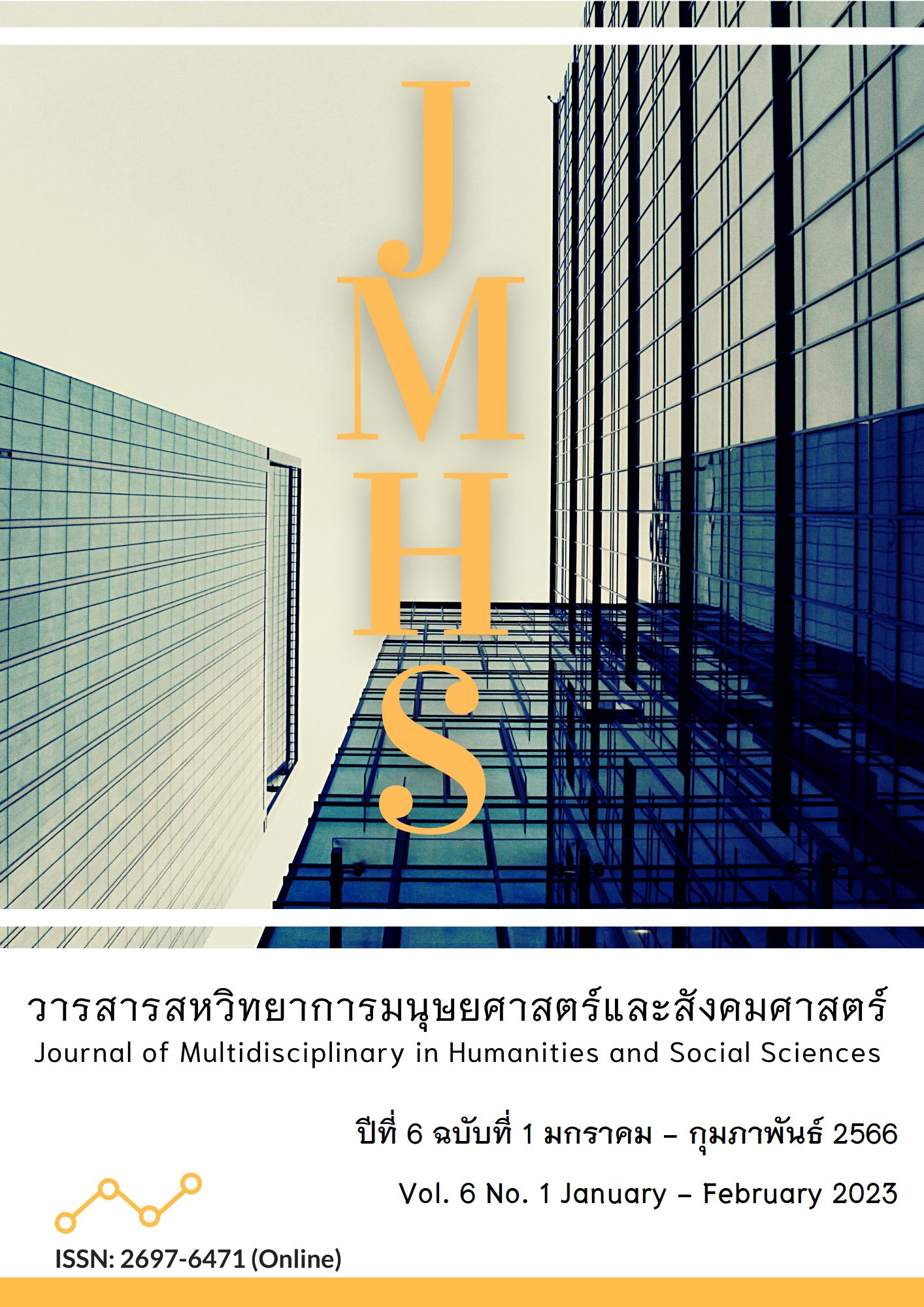Buddhist Psychotherapy: An Analysis in Nursing Dimension
Main Article Content
Abstract
Psychosis, according to the Western psychological view, is a disease of the body that is caused by the brain and the environment. The patient will have behavior that is characteristic of a madman or insane person, so the treatment is physical healing by doctors. But mental illness, from the Buddhist viewpoint, is a false view because the mind is overwhelmed by the power of defilements and craving. If people do not control their minds and do not use consciousness to consider things, The mind will think and order the body to act according to the power of defilements and cravings. There is tension in the body and mind, causing health problems and physical diseases. If the tension always arises and intensifies until the brain and nervous system become unbearable, people will behave like madmen or insane people, which is a physical disease. Treatment must involve physical healing by doctors and using medication. As for the false view, they must be treated in the mind in order to turn negative energy into positive ones. One method is to do Buddhist psychotherapy. The principle is to start with the therapist talking to the patient to find out the root cause of the problem and relieve the suffering that has been endured for a long time. Then it will be the process of controlling the mind, starting with making consciousness happen by practicing mindfulness on breathing, knowing posture, and knowing every movement and every action so that the mind will not be distracted in order to make consciousness more complete. Then the physical tension and mental distress of the patient will gradually decrease. The last step is to change the attitude and behavior by practicing the five precepts and five dhammas for peaceful living.
Article Details

This work is licensed under a Creative Commons Attribution-NonCommercial-NoDerivatives 4.0 International License.
Views and opinions appearing in the Journal it is the responsibility of the author of the article, and does not constitute the view and responsibility of the editorial team.
References
กรมสุขภาพจิต. (2541). คูมือคลายเครียด. (พิมพ์ครั้งที่ 6). กรุงเทพฯ: ดีไซน์คอนดักชั่น.
จุฑามาศ แหนจอน. (2561). อารมณ์และการจัดการความเครียด. (พิมพ์ครั้งที่ 5). ชลบุรี: เก็ทกู๊ด ครีเอชั่น.
ชมพูนุท ศรีจันทร์นิล. (2552). จิตวิทยาแนวพุทธ : แนวทางเพื่อการเยียวยาและพัฒนาจิตใจมนุษย์ วารสารวิชาการ มหาวิทยาลัยหอการค้าไทย, 29(4), 188-208.
ทัศนีย์ ทองประทีป. (2552). จิตวิญญาณ : มิติหนึ่งของการพยาบาล. กรุงเทพฯ: จุฬาลงกรณ์มหาวิทยาลัย.
นวนันท์ ปิยะวัฒน์กูล และคณะ. (2563). จิตเวชศาสตร์. (พิมพ์ครั้งที่ 3). สมุทรสาคร: สยามทองกิจ.
ประยงค์ สุวรรณบุบผา. (2544 ก). จิตบำบัดแนวพุทธศาสน์ เล่ม 1. นครปฐม: โรงพิมพ์มหามกุฏราชวิทยาลัย.
ประยงค์ สุวรรณบุบผา. (2544 ข). จิตบำบัดแนวพุทธศาสน์ เล่ม 2. นครปฐม: โรงพิมพ์มหามกุฏราชวิทยาลัย.
พระธรรมปิฎก (ป.อ. ปยุตฺโต). (2539). จากจิตวิทยาสู่จิตภาวนา. (พิมพ์ครั้งที่ 6). กรุงเทพฯ: มูลนิธิพุทธธรรม.
พระพรหมคุณาภรณ์ (ป.อ. ปยุตฺโต). (2551). การแพทย์ยุคใหม่ ในพุทธทัศน์. (พิมพ์ครั้งที่ 6). กรุงเทพฯ: สหธรรมมิก.
พระราชพรหมยาน (วีระ ถาวโรมหาเถร). (2541). คู่มือปฏิบัติคู่วัดท่าซุง เล่ม 1. ม.ป.ท.
พระศรีวิสุทธิกวี (พิจิตร ฐิตวณฺโณ). ม.ป.ป. การบริหารจิต. กรุงเทพฯ: สภาการศึกษามหามกุฎราชวิทยาลัย.
พุทธทาส อินทปัญโญ. (ม.ป.ป.). แก่นพุทธศาสน์. กรุงเทพฯ: สถาบันบันลือธรรม.
มหาจุฬาลงกรณราชวิทยาลัย. (2539). พระไตรปิฎกภาษาไทยฉบับมหาจุฬาลงกรณราชวิทยาลัย. กรุงเทพฯ: โรงพิมพ์มหาจุฬาลงกรณราชวิทยาลัย.
ยาใจ สิทธิมงคล และคณะ (บรรณาธิการ). (2561). การพยาบาลจิตเวชศาสตร์. ฉบับปรับปรุง ครั้งที่ 1. (พิมพ์ครั้งที่ 3). กรุงเทพฯ: สแกนอาร์ต.
ราชบัณฑิตยสถาน. (2556 ก). พจนานุกรมฉบับราชบัณฑิตยสถาน พ.ศ. 2554. (พิมพ์ครั้งที่ 2). กรุงเทพฯ: ราชบัณฑิตยสถาน.
ราชบัณฑิตยสถาน. (2556 ข). พจนานุกรมศัพท์จิตวิทยา. (พิมพ์ครั้งที่ 2). กรุงเทพฯ: ธนาเพรส.
สมภพ เรืองตระกูล. (2548). จิตเวชศาสตร์. (พิมพ์ครั้งที่ 9). กรุงเทพฯ: เรือนแก้วการพิมพ์.
สมภาร พรมทา. (2548). พุทธปรัชญา : มนุษย์ สังคมและปัญหาจริยธรรม. (พิมพ์ครั้งที่ 2). กรุงเทพฯ: ส่องศยาม.
สมเด็จพระญาณสังวร สมเด็จพระสังฆราช สกลมหาสังฆปริณายก. (2537). ธรรมดุษฎี. กรุงเทพฯ: ส่องศยาม.
สุรีย์ กาญจนวงศ์. (2553). จิตวิทยาสุขภาพ. (พิมพ์ครั้งที่ 2). นครปฐม: โรงพิมพ์มูลนิธิมหามกุฎราชวิทยาลัย.
ฤทธิรงค์ หาญรินทร์ และ สมพร รุ่งเรืองกลกิจ. (2551). การให้การปรึกษารายบุคคลแนวพุทธศาสนาในผู้ป่วยเรื้อรังที่มีภาวะซึมเศร้า.” วารสารสุขภาพจิตแห่งประเทศไทย, 16(1), 14-23.
Capra, F. (1975). The Tao of Physics. Colorado: Shambhala Publications.
Fink, G. (2009). Stress: Definition and history. In: Squire L, ed-in-chief. Encyclopedia of Neuroscience. Oxford: Elsevier.
Frank, J.D. (1986). Psychotherapy-The Transformation of Meanings: Discussion paper. J. R. Soc. Med, 79, 341–346.
Rungreangkulkij, S., & Wongtakee, W. (2008). The Psychological Patients Suffering from Symptoms of Anxiety. Archives of Psychiatric Nursing, 22(3), 127-134.
Wolberg, L.R. (1967). The Technique of Psychotherapy. New York: Grune & Stratton.


